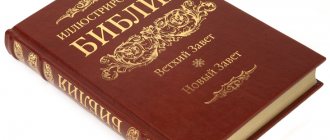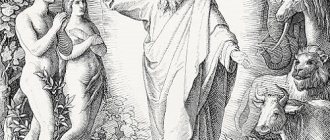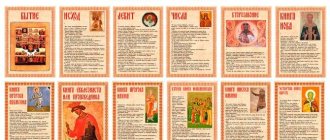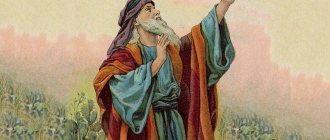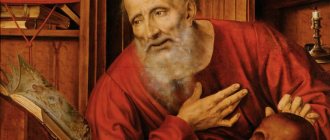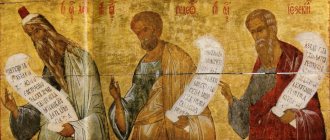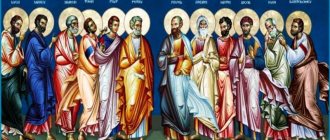Books of the New Testament
The New Testament contains 27 books. The main books of the New Testament are the Gospels
from
Matthew, Mark, Luke and John,
making up the Four Gospels.
Gospel
(euaggelion) translated from Greek means “Good News, Good News” and implies the news of the coming to earth of the Savior - Jesus Christ. The books of the Four Gospels were written in the 1st century AD, with the first three no later than the 60s, and the Gospel of John no later than the end of the 1st century.
The first three Gospels, which are similar to each other, differ from the Gospel of John the Theologian in the order and nature of their presentation. They convey information about the life of Christ in sequential order and are called synoptic
(Greek “synopsis” - “review”).
The Evangelist John does not adhere to this order. Without saying anything about the history of the birth of Jesus Christ, he directly begins to preach the gospel about His Divinity:
“In the beginning was the Word, and the Word was with God, and the Word was God. It was in the beginning with God. Everything came into being through Him, and without Him nothing came into being that came into being. In Him was life, and life was the light of men. And the light shines in the darkness, and the darkness does not overcome it.
There was a man sent from God; his name is John. He came as a witness, to testify about the Light, so that through him all might believe. He was not light, but was sent,
to testify to the Light.
There was true Light. Who enlightens every person who comes into the world. He was in the world, and the world came into being through Him, and the world did not know Him. He came to his own, and his own did not receive Him. And to those who received Him, to those who believed in His name, He gave the power to become children of God, who were born neither of blood, nor of the will of the flesh, nor of the will of a man, but of God.
And the Word became flesh and dwelt among us, full of grace and truth; and we have seen His glory, glory as of the only begotten of the Father” (John 1:1-14).
In addition to the Four Gospels, the New Testament includes: The Acts of the Holy Apostles, The Epistles of the Holy Apostles. Apocalypse, or Revelation of St. John the Theologian.
1. Book “The Acts of the Holy Apostles”
is, as it were, a continuation of the Gospel.
As can be seen from the first lines of the narrative, it was written by the Evangelist Luke and continues the content of the last chapter of the Gospel of Luke. The book of the Acts of the Apostles tells about the deeds of the apostles: about the descent of the Holy Spirit on the apostles, about their preaching labors after the resurrection of Christ, about the emergence and life of the first Christian communities, about the first martyrs for Christ, about the rapid spread of Christianity among the Israelis and pagans. The Acts of the Holy Apostles tells about the miraculous conversion of Saul (Apostle Paul)
to Christ, about his labors, missionary travels and sufferings.
Saul sincerely loved God, but, being a faithful Jew, he was a persecutor of Christians. Considering believers in Christ to be dangerous troublemakers, he was convinced that he was doing a godly deed by destroying them. For
such spiritual blindness, he was literally blinded, but after turning to Christ he was healed and was called to apostolic service. These events, as well as the missionary activities of Paul and the other apostles, the exploits and sufferings they accepted for Christ, are described in the Acts of the Apostles.
2. Epistles of the Holy Apostles
- these are letters of the apostles to the first Christian communities, to the Church, to individuals. The messages contain many details about the life of the first Christians, explain the teachings of Christ, talk about the missionary journeys of the apostles Paul, Peter, Barnabas and others, about the spread of Christianity in the ancient world, about the fate of the world, about the resurrection and eternal life. The Epistles include 21 books, of which seven are conciliar epistles (addressed to all Christians) and fourteen epistles of the Apostle Paul. Council messages:
• Council Epistle of the Apostle James;
• 1 and 2 Epistles of the Apostle Peter;
• 1st, 2nd and 3rd Council Epistles of the Apostle John the Theologian;
• Council Epistle of the Apostle Jude.
• Fourteen Epistles of the Apostle Paul
(Romans, 1 and 2 Corinthians, Galatians, Ephesians, Philippians, Colossians, 1 and 2 Thessalonians, 1 and 2 Timothy, Titus, Philemon and Hebrews) .
Christians have been guided by these works of the apostles from ancient times to the present day. The content of these messages, as well as the Holy Tradition, cover all areas of the spiritual and practical life of the Church of Christ.
3. Apocalypse, or Revelation of St. John the Theologian.
This mysterious book in symbolic form reveals the future destinies of the world and predicts the end of world history. God's Judgment on people, the coming to earth of the Antichrist (antipode, the opposite of Christ), the death of the Antichrist. The Second Coming of Christ, the resurrection of the dead, the complete and final triumph of Christ's Church. The revelation was received by the apostle and evangelist John the Theologian on the island of Patmos, where he was exiled for preaching the word of God.
“The Bible belongs to everyone, atheists and believers alike. This is the book of humanity" F. M. DOSTOEVSKY
Structure of the Bible
The Holy Scriptures are divided into two parts:
- The Old Testament is those books that were written before the appearance of Jesus Christ in the world.
- The New Testament was written down by the holy apostles after the coming of the Savior.
The word “covenant” itself is literally translated as “command,” “teaching,” “instruction.” Its symbolic meaning is the creation of an invisible union between God and man. Both of these parts are equivalent and together form a single Holy Scripture.
The Old Testament, representing the more ancient union of God with man, was created immediately after the fall of the ancestors of mankind. Here God gave them a promise that the Savior would come to the world.
The Holy Scriptures of the New Testament are based on the fact that the Savior promised by the Lord appeared to the world, taking on human nature, and became like people in everything. Throughout his short life, Jesus Christ showed that she can be free from sin. Having resurrected, he gave people the great grace of renewal and sanctification by the Holy Spirit for the continuation of life in the Kingdom of God.
Good news to the Virgin Mary (Luke 1:26-38)
God sent Archangel Gabriel
to the city
of Nazareth to the Virgin Mary,
betrothed to
Joseph,
a descendant of King David. The angel said to Mary: “Rejoice, full of grace! The Lord is with You; Blessed are You among women."
The Virgin Mary was confused by these words and wondered what they could mean. The angel said: “Do not be afraid, Mary, for you have found favor with God. A Son will be born to You, and You will give Him the name Jesus. He will be great, for He is the Son of the Most High God.”
The Virgin Mary was perplexed: “How will this be when I don’t know my husband?” The angel answered: “The Holy Spirit will come upon you and the power of the Most High will overshadow you; therefore the Holy One who is to be born will be called the Son of God.” Then Mary answered: “I am the servant of the Lord; let it be done to me according to your word.”
Mary visits Elizabeth (Lk 1:39-56)
In the mountains of Judea lived an elderly priest, Zechariah
with his wife
Elizabeth,
who was a relative of the Virgin Mary. These were very pious people. Elizabeth at that time was expecting a child, the future Baptist of the Lord.
The Virgin Mary went to her to help. When She entered Zechariah's house, Elizabeth was filled with the Holy Spirit and greeted Her with the words: “Blessed are You among women, and blessed is the fruit of Your womb! And where does it come from for me that the Mother of my Lord came to me?” The Most Holy Virgin answered: “My soul magnifies (glorifies) the Lord, and My spirit rejoices in God, My Savior, that He has looked upon the humility of His servant; for from now on all generations will call Me blessed.”
The Virgin Mary stayed with Elizabeth for three months until John was born.
who was destined to become
the Forerunner and Baptist of the Lord.
SUFFERING. THE DEATH AND RESURRECTION OF JESUS CHRIST
***
The Crucifixion of the Lord Jesus Christ (Matt. 27:1-54; Luke 23:1-49;
In. 18:12-40, 19:1-37)
The Jews brought the Lord to the Roman governor Pontius Pilate, demanding the death penalty for Christ. Pilate, not finding any guilt in him, ordered the soldiers to scourge him, hoping that the Jews would be satisfied. Mocking Christ, the soldiers put a crown of thorns on Him,
they beat and mocked him, and then scourged him.
But the Jews did not let up and continued to insist on the execution of Christ. They persuaded the people to demand the crucifixion of Christ. And the same people who a few days ago shouted to Christ: “Hosanna,” now shouted: “Crucify Him!” The reason was that these people thought about earthly things:
about his independence, power over other peoples and about earthly well-being, therefore the idea of eternal life through salvation from sins, passions and evil was incomprehensible to him. The Jews understood and accepted the words “king” and “Kingdom of God” in the sense of earthly reign and dominion of God’s chosen people.
As you know, selfishness and selfishness turn any idea into evil, blind people, deprive their lives of spiritual meaning, and fill their activities with lies, hatred, greed and crimes.
At the request of the Jews, Pilate sentenced the Savior to death on the cross (even despite the fact that Pilate’s wife asked him not to cause Him any harm). The tortured Christ had to carry His cross Himself to Golgotha, the place of execution. This was the custom in those days. Christ was crucified along with two thieves, whose crosses on Calvary were to the right and left of Him. One of them mocked Christ, and the one on the right calmed the robber: “Or are you not afraid of God, when you yourself are condemned to the same thing? And we are condemned justly, for we accepted what was worthy of our deeds, but He did nothing bad.” Then he said to Christ: “Remember me. Lord, when will you come into your kingdom.” Christ answered: “Truly I tell you, today you will be with Me in Paradise.”
At the cross stood Mother and John, whom He commanded to become mother and son to each other. From that time on, John took the Mother of God to himself. And the Mother of God, through John, adopted the entire human race.
Around six o'clock in the afternoon darkness came and lasted until the ninth hour. Suddenly the earth shook, the sun darkened, and the curtain in the Jerusalem temple was torn in two. At the ninth hour the Son of God cried out in a loud voice: “Eloi, Eloi! lamma sabachthani? (which means: “My God, My God! why have you forsaken me?”). After this, Christ gave up his ghost.
Resurrection of Christ (Matt. 28:1-8; Mark 16:1-7; Luke 24:1-7)
Two Godly Men: Joseph of Arimathea
and
Nicodemus -
they took the Body of the Lord from the cross, wrapped it in the Shroud (pure white linen) and laid it in a coffin (a cave carved into the rock served as the coffin).
At the request of the Jewish high priests, a guard was placed at the tomb, and a seal was attached to the stone closing the entrance to the cave so that no one could steal the Body of Christ. But on the third day, the greatest miracle happened, which is narrated in the Gospel and testified by the Shroud of Turin. Christ rose from the dead and came out of the Shroud without unfolding it, and remained on earth for 40 days, and then, in front of the eyes of the disciples, ascended to heaven.
The first to learn about the resurrection of Christ were three women who came to the garden where His tomb was to anoint His Body with the aromatic oils they brought. Approaching the tomb, they saw that the stone had been rolled away, and in the cave there was an angel who informed them about the resurrection of Christ and sent them to tell His disciples about everything they had seen and heard.
The names of these women, now called myrrh-bearers
(myrrh - fragrant oil):
Salome -
the mother of John and James Zebedee, Mary - the mother of James Alphaeus, and
Mary Magdalene.
Book materials used:
A.V. Borodina Fundamentals of Orthodox Culture, Moscow, “Pokrov”, 2003
Orthodox icons:
| A | B | B | G | D | E | F | Z | And | K | L | M | N | About | P | R | C | T | U | F | X | C | H | SH-SH | E | Yu | I |
All religious terms:
Prayers before and after reading the Gospel
Brief prayer before reading the Gospel
Lord Jesus Christ! Open the eyes of my heart, so that I may hear Your word and understand it and do Your will.
The prayer is different
Shine in our hearts, O Lord, the love of mankind, of Your knowledge of God, the imperishable light, and open our mental eyes to the understanding of Your gospel sermons, invest in us and Your blessed ones for lead us to fear, so that all carnal lusts may be trampled, let us pass through spiritual life, all of which is to please You and wisely and active. For You are the enlightenment of our souls and bodies, O Christ God, and we ascribe glory to You, with Your Beginning Father and Your All-Holy, and Good, and Life-giving Spirit, now and ever forever and ever, amen.
Rambam - about fake religions
What danger does the New Testament pose to the Jewish people? Rambam's (Maimonides) letter, “The Epistle to Yemen, or the Gate of Hope,” sent to Yemen from Cairo in 1172, explains in detail the harmful nature of counterfeit religions.
“And then a new sect arose... it set out to plague our people in a new way. This attacker was Yeshua from Nazareth - a Jew. He pretended to be a messenger of God who came to clarify ambiguities in the Torah, claiming to be the Messiah promised to us by all the prophets. His interpretation of the Torah, in full accordance with his plan, led to the abolition of it and all its commandments and allowed the violation of all its warnings. A considerable time after his death, a religion arose, of which he is considered the founder. It spread among the sons of Esau, whose conversion he himself had not even thought of.
Both of them (Yeshu and Muhamed) passionately desired to liken their lies to the Divine law. But what is created by man can be likened to what was created by the Almighty only in the eyes of a child who does not understand anything...
Daniel explains to us that the intention of that (false prophet) will be to undermine and annul, to replace the Torah, which is in our hands, as it is said: “And he will dream of changing the (timed) times (of their holidays) and their law, and they will be given into his hands for a term, and terms, and half a term” ( Daniel 7:25
)”.
Bible Interpretation
It is obvious that the interpretation of Holy Scripture is a complex matter and not everyone can do it. Acquaintance with a teaching of this level requires special concentration from a person. Because God may not reveal the meaning inherent in a particular chapter.
There are several basic rules to follow when interpreting the provisions of Holy Scripture:
- Consider all the events described not in isolation, but in the context of the time when they occurred.
- Approach the process with due reverence and humility so that God allows the meaning of the biblical books to be revealed.
- Always remember who the author of the Holy Scripture is, and when contradictions arise, interpret it based on the context of the entire message as a whole. Here it will be important to understand that there can be no contradictions in the Bible, since it is complete and its author is the Lord himself.
Inspiration of Holy Scripture
The books that together form the Holy Scriptures of the Old and New Testaments are called inspired because they were written by the inspiration of the Holy Spirit. In other words, we can say that their only and real author is none other than the Lord God himself. It is he who, defining them in a moral and dogmatic sense, enables man to realize God’s plan through creative work.
That is why the Holy Scripture has two components: divine and human. The first contains the Truth revealed by God himself. The second expresses it in the language of people who lived in one of the eras and belonged to a certain culture. Man, who is created in the image and likeness of God, is endowed with the unique opportunity to enter into direct communication with the Creator. God, being all-wise and omnipotent, has all the means to communicate his revelation to people.
False messiahs in the history of the Jewish people [↑]
Belief in the coming of the Messiah has always been an important part of Jewish doctrine. The Jewish teacher of the law (Rambam) included this belief among the 13 basic principles of Judaism.
Mashiach is a Jewish leader, a man of flesh and blood, possessing exceptional wisdom, firmness and fortitude. It is he who will bring complete - physical and spiritual - deliverance to the Jewish people and establish eternal peace, love, prosperity and moral perfection throughout the entire earth.
Rambam in his fundamental work “Yad Chazaka” writes: “If he succeeded in his endeavors and defeated all the surrounding nations, and built the Temple in the place designated for it, and gathered Jews from the countries of dispersion, this is undoubtedly the Moshiach.” If all this did not happen, then “it is obvious that this was not the one whose appearance was promised by the Torah, but simply one of the kings of the dynasty of David, righteous and worthy, who died. And the Almighty made his appearance a test for the people.” And there have been several such trials in the history of the Jewish people.
During one of the difficult periods, when the Temple had been in ruins for more than 60 years, and most of the Jews were in Galut - Exile, scattered throughout the territory of the Roman Empire, the Roman Emperor Hadrian decided to build a fortress on the site of Jerusalem and populate it with pagans.
A man of unprecedented courage and fearlessness, Shimon Bar Kozeva led the Jews in an uprising against the Romans and soon cleared almost the entire Eretz Israel
.
Rabbi Akiva and other sages of that generation believed that Bar Kozev had the potential to become the long-awaited Moshiach. That’s why they began to call him Bar Kochba
- literally:
“son of the Star
.
Rabbi Akiva believed that it was he who was spoken of in the verse: “A star rose from Jacob.” However, after Bar Kozeva was killed by the Romans, it became clear that he was not the Moshiach
that everyone was waiting for.
Another famous pseudo-messiah, Shabtai Zevi, was born in the Ottoman Empire in 1626. From one passage in the book of Zohar it was concluded that Moshiach will come in 5408
year from the creation of the world (1648). Shabtai Zvi, who was an exalted ascetic student of Kabbalah, believed that Moshiach was himself. Crowds of enthusiastic Jews began to follow Shabtai, their numbers kept growing. The Sabbatian movement from Turkey spread throughout Europe. The Jews were broken by the terrible tragedy in Ukraine in 1648 - the Khmelnytsky genocide, the murder of hundreds of thousands of innocent people - and ongoing suffering, so they enthusiastically accepted the news of “imminent deliverance.”
Most rabbis of that time did not accept Shabtai as Moshiach, but did not announce this in the hope that repentance, correction and fulfillment of mitzvot
will not be in vain for the Jews, even if Mashiach does not come. Others remained silent for the sake of maintaining peace, in order to avoid conflicts. And only the rabbi of the Hamburg community, Rabbi Yaakov Sasportas (Saspoorts), tirelessly wrote letters to rabbis and community leaders in other cities, claiming that Shabtai Tzvi was a false messiah. But it was only after Shabtai converted to Islam that the Jews had to face the truth, although Sabbatianism as a sect continued to exist until the 19th century.
Exactly one hundred years after the birth of Shabtai Zvi - in 1726 - Yakov Leibovich Frank was born in southern Galicia. Having met the Turkish Sabbatians and becoming one of the members of the sect, Frank began to develop the theory of the transmigration of the soul of the Moshiach from the body of one person to the body of another. Soon Frank managed to convince a number of Jews that the soul of Moshiach was now in his body. But this “Mashiach” only led his Jewish followers away from Judaism, turning out to be a false prophet.
As we see, Jesus of Nazareth was not the only person whom the Jews considered Moshiach. And even in our time in Jerusalem from time to time there appear people who proclaim themselves Saviors. (In the Jerusalem psychiatric hospital Givat Shaul there is an entire department for “Mashiachs,” and this mass phenomenon is even described as the “Jerusalem Mashiism Syndrome”).

